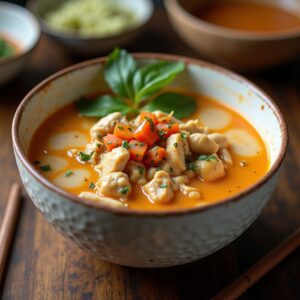

Combat Chronic Fatigue and Pain with an Anti-Inflammatory Diet


Arya Soleil
Chronic inflammation is more than just a buzzword—it is a persistent, low-grade condition that can sap your energy, intensify pain, and diminish your quality of life. When the body’s natural inflammatory response lingers beyond its useful purpose, it creates a toxic environment that not only disrupts daily functioning but also fuels conditions like fibromyalgia, chronic fatigue syndrome, rheumatoid arthritis, and lupus. Fortunately, adopting an anti-inflammatory diet can be a transformative strategy to counter these debilitating effects. In this blog, we’ll explore the science behind chronic inflammation, detail the foods that can help combat it, outline practical tips for incorporating this approach into your lifestyle, and share how these dietary changes can empower you to reclaim your health and energy.
Understanding Chronic Inflammation
Inflammation is a natural defense mechanism designed to protect the body from injury and infection. In its acute form, inflammation is beneficial—it signals the immune system to repair damaged tissues and ward off pathogens. However, when inflammation becomes chronic, it turns into an insidious process that continuously triggers immune responses, leading to persistent fatigue, widespread muscle and joint pain, and a marked reduction in energy levels.
Chronic inflammation disrupts the normal functioning of cells and tissues. It interferes with sleep patterns and impairs cellular repair processes, which can cause a cascade of problems throughout the body. Over time, this sustained inflammatory state is closely linked to systemic disorders such as fibromyalgia and rheumatoid arthritis. For individuals dealing with these conditions, the constant cycle of inflammation not only heightens physical discomfort but also affects mental well-being, making daily tasks and activities overwhelmingly challenging.
The Science Behind the Anti-Inflammatory Diet
The anti-inflammatory diet is built on the principle of consuming foods that naturally reduce inflammation in the body. At its core, this approach emphasizes whole, nutrient-dense foods that provide antioxidants, vitamins, and essential fatty acids—each playing a critical role in fighting inflammation and restoring balance. Scientific studies have shown that diets rich in fruits, vegetables, lean proteins, and healthy fats can help lower markers of inflammation, thereby reducing the intensity of chronic pain and fatigue.
Key to this diet is the inclusion of high-fiber, antioxidant-rich fruits and vegetables. Foods like leafy greens, berries, and squash are loaded with phytonutrients that help neutralize harmful free radicals. Additionally, omega-3 fatty acids found in fatty fish, flaxseeds, and walnuts have been shown to reduce the production of inflammatory chemicals in the body. When combined with easily digestible whole grains such as quinoa and brown rice, these ingredients create a robust nutritional foundation that supports overall health and helps mitigate the effects of chronic inflammation.
Foods That Fight Inflammation
An anti-inflammatory diet is not about strict deprivation but about embracing a variety of foods that work in synergy to reduce inflammation and promote healing. Here’s a closer look at the essential components:
1. Fruits and Vegetables
These are the cornerstone of the anti-inflammatory diet.
- Leafy Greens: Spinach, kale, and Swiss chard are packed with vitamins A, C, and K, as well as antioxidants that help reduce inflammation.
- Berries: Blueberries, strawberries, and raspberries provide powerful antioxidants like anthocyanins that help combat oxidative stress.
- Other Produce: Vegetables like broccoli, Brussels sprouts, and squash also offer a rich supply of anti-inflammatory nutrients.
2. Whole Grains
Whole grains are a great source of fiber and essential nutrients.
- Quinoa and Brown Rice: These grains are not only easy on the digestive system but also help maintain steady blood sugar levels, which can be beneficial for overall energy management.
- Oats and Barley: These also contribute fiber and help promote a healthy gut environment, which is closely linked to inflammation regulation.
3. Lean Proteins
Protein is essential for muscle repair and immune function.
- Poultry, Tofu, and Wild-Caught Fish: These provide high-quality protein without the saturated fats found in some other sources. Wild-caught fish, in particular, is rich in omega-3 fatty acids, which are potent anti-inflammatory agents.
4. Healthy Fats
Incorporating healthy fats can make a significant difference.
- Fatty Fish and Flaxseeds: These are among the best sources of omega-3 fatty acids.
- Nuts and Avocados: They offer monounsaturated fats that support heart health and reduce inflammation.
5. Herbs and Spices
Certain herbs and spices are renowned for their anti-inflammatory properties.
- Turmeric: Curcumin, the active ingredient in turmeric, is a powerful anti-inflammatory compound.
- Ginger: Known for its ability to soothe the digestive tract and reduce inflammatory markers.
6. Hydration and Herbal Teas
Staying hydrated is essential for flushing toxins from the body.
- Herbal Teas: Teas made from chamomile, ginger, or green tea provide additional antioxidants and can soothe inflammation.
Foods to Avoid
Just as important as knowing what to eat is understanding which foods to steer clear of. Certain foods can trigger or exacerbate inflammation, making symptoms worse:
- Ultra-Processed Foods: These often contain additives and preservatives that can provoke inflammatory responses.
- Refined Sugars and Carbohydrates: High sugar intake leads to spikes in insulin, which can promote inflammation.
- Trans Fats: Often found in fried foods, baked goods, and some margarines, these fats are notorious for their role in increasing inflammation.
- Excessive Alcohol and Caffeine: While moderate consumption might be acceptable, overindulgence in these substances can worsen inflammation and disrupt sleep patterns.
- Artificial Additives: Preservatives and flavor enhancers may trigger sensitivities that contribute to systemic inflammation.
Practical Tips for Embracing the Anti-Inflammatory Lifestyle
Transitioning to an anti-inflammatory diet might seem daunting at first, especially if you’re used to a diet high in processed and inflammatory foods. However, with thoughtful planning and a gradual approach, you can successfully integrate this diet into your daily routine. Here are some practical tips to help you get started:
1. Gradual Dietary Transition
Instead of overhauling your diet overnight, start by incorporating one or two anti-inflammatory meals per day. Gradually increase the number of healthy meals while reducing inflammatory foods. This approach helps your body adjust without triggering drastic changes that might lead to discomfort or cravings.
2. Thoughtful Meal Planning
Planning your meals in advance can make a significant difference. Create a weekly menu that prioritizes anti-inflammatory foods, and keep healthy snacks on hand—such as fresh fruit, nuts, or vegetable sticks—to avoid the temptation of ultra-processed options.
3. Easy Meal Preparation
Look for recipes that require minimal prep time and energy. Simple dishes like quinoa salads with leafy greens and grilled wild-caught fish or smoothies packed with berries and flaxseeds can provide a nutritious, low-effort solution to mealtime challenges.
4. Hydration Habits
Incorporate herbal teas into your daily routine. Besides providing antioxidants, these teas can soothe your digestive system and help reduce inflammation. Carry a reusable water bottle to ensure you remain well-hydrated throughout the day.
5. Seek Professional Guidance
Every individual’s nutritional needs are unique. Consulting a healthcare professional or a registered dietitian can provide personalized advice that ensures your anti-inflammatory diet meets your specific needs while aligning with any medical requirements or restrictions.
The Impact on Chronic Fatigue and Pain
The benefits of an anti-inflammatory diet extend far beyond nutritional adequacy—they offer a practical solution for reducing chronic fatigue and alleviating pain. For those battling conditions like fibromyalgia, chronic fatigue syndrome, and rheumatoid arthritis, the long-term inflammatory response can be debilitating. By adopting a diet rich in anti-inflammatory nutrients, many individuals have reported:
- Increased Energy Levels: A more balanced diet supports better sleep and improved cellular repair, leading to sustained energy throughout the day.
- Reduced Pain: Lower levels of systemic inflammation correlate with a decrease in muscle and joint pain, making physical activity and daily tasks more manageable.
- Improved Quality of Life: With less fatigue and pain, individuals can participate more fully in activities they enjoy, fostering better mental health and overall well-being.
Real-world testimonials and emerging scientific research both underscore the transformative potential of an anti-inflammatory diet. Patients who have made the switch often speak of a renewed sense of vitality and an ability to reclaim control over their health.
Real-World Success and Scientific Support
Numerous studies have highlighted the role of diet in managing chronic inflammation. Research shows that diets high in antioxidants and omega-3 fatty acids can significantly reduce inflammatory markers, offering relief to those with chronic pain and fatigue. Beyond the lab, many individuals have embraced this dietary approach with encouraging results.
Consider the story of Sarah, a long-time sufferer of chronic fatigue syndrome, who began incorporating more leafy greens, berries, and omega-3-rich foods into her meals. Over several months, Sarah noticed a gradual yet profound improvement in her energy levels and a marked decrease in joint pain. Her story is echoed by countless others who have transformed their lives through mindful eating practices.
In addition to anecdotal evidence, the growing body of scientific literature supports the anti-inflammatory diet as a sustainable and effective approach for managing chronic inflammation. This research not only validates the dietary changes but also provides a framework for further exploring how nutrition can be harnessed to improve long-term health outcomes.
Conclusion
The journey to better health often begins on your plate. Chronic inflammation may be an invisible adversary, but with the right dietary strategy, its effects can be mitigated. An anti-inflammatory diet—rich in fruits, vegetables, lean proteins, whole grains, healthy fats, and potent herbs and spices—offers a powerful tool to combat the persistent fatigue and pain that diminish quality of life. By thoughtfully reducing or eliminating inflammatory foods and adopting practical meal-planning strategies, you can create a sustainable, healthful eating plan that supports cellular repair, boosts energy, and eases chronic pain.
This holistic approach not only alleviates the physical manifestations of chronic inflammation but also empowers you to regain control over your wellbeing. With professional guidance, gradual transitions, and a commitment to whole-food nutrition, the anti-inflammatory diet provides a proven pathway to reduced inflammation and improved vitality.
As you embark on this journey, remember that every small change can have a profound impact over time. Whether you are managing a specific condition or simply looking to optimize your health, the choices you make today lay the foundation for a healthier, more energetic tomorrow. Embrace the anti-inflammatory lifestyle and join the growing community of individuals who have transformed their lives by reclaiming their energy, reducing pain, and ultimately, enhancing their overall quality of life.
By taking proactive steps toward a nutrient-dense, inflammation-fighting diet, you can pave the way for long-term health benefits. The path may require some adjustments and experimentation, but the rewards—more energy, less pain, and a renewed zest for life—are well worth the effort. Start with one meal, one snack, one healthy choice at a time, and soon you’ll be enjoying the cumulative benefits of an anti-inflammatory lifestyle that supports both body and mind.
Ultimately, the anti-inflammatory diet isn’t just a short-term fix; it’s a sustainable long-term strategy for living better. With a focus on whole foods, balanced nutrition, and mindful eating habits, you can combat chronic fatigue and pain while laying the groundwork for a vibrant, healthier future. Embrace this approach, and empower yourself to not only manage your symptoms but also to thrive—reclaiming both your health and your happiness.
By transforming your relationship with food and prioritizing natural, nutrient-rich ingredients, you are taking a significant step toward reducing chronic inflammation and its associated challenges. The journey might seem gradual, but the impact is lasting. Let this anti-inflammatory approach be your guide to reclaiming your vitality, improving your daily performance, and living a life marked by reduced pain and increased energy. The power to change is on your plate—embrace it today.
Recommended Reads

- March 22, 2025
Anti-Inflammatory Breakfasts: Easy Recipes to Start Your Day Right
Home News Healthy Habits & Lifestyle Health Conditions &...


- March 22, 2025
Questioning the FDA: A Deeper Look at the Food and Drug Administration’s Role
Home News Healthy Habits & Lifestyle Health Conditions &...


- March 22, 2025
Make ‘Raw Milk’ Just ‘Milk’ Again: A Closer Look at the Raw Milk Debate
Home News Healthy Habits & Lifestyle Health Conditions &...


- March 22, 2025
The Power of Sweet Potatoes: A Superfood for Eyes, Skin, and Beyond
Home News Healthy Habits & Lifestyle Health Conditions &...


- March 22, 2025
Sugar-Free: A Code Word for “We’ve Replaced It with Something Worse for You”
Home News Healthy Habits & Lifestyle Health Conditions &...


- March 22, 2025
The Evolution of Food: How Modern Diets Are Fueling Chronic Disease
Home News Healthy Habits & Lifestyle Health Conditions &...

Combat Chronic Fatigue and Pain with an Anti-Inflammatory Diet

Chronic inflammation is more than just a buzzword—it is a persistent, low-grade condition that can sap your energy, intensify pain, and diminish your quality of life. When the body’s natural inflammatory response lingers beyond its useful purpose, it creates a toxic environment that not only disrupts daily functioning but also fuels conditions like fibromyalgia, chronic fatigue syndrome, rheumatoid arthritis, and lupus. Fortunately, adopting an anti-inflammatory diet can be a transformative strategy to counter these debilitating effects. In this blog, we’ll explore the science behind chronic inflammation, detail the foods that can help combat it, outline practical tips for incorporating this approach into your lifestyle, and share how these dietary changes can empower you to reclaim your health and energy.
Understanding Chronic Inflammation
Inflammation is a natural defense mechanism designed to protect the body from injury and infection. In its acute form, inflammation is beneficial—it signals the immune system to repair damaged tissues and ward off pathogens. However, when inflammation becomes chronic, it turns into an insidious process that continuously triggers immune responses, leading to persistent fatigue, widespread muscle and joint pain, and a marked reduction in energy levels.
Chronic inflammation disrupts the normal functioning of cells and tissues. It interferes with sleep patterns and impairs cellular repair processes, which can cause a cascade of problems throughout the body. Over time, this sustained inflammatory state is closely linked to systemic disorders such as fibromyalgia and rheumatoid arthritis. For individuals dealing with these conditions, the constant cycle of inflammation not only heightens physical discomfort but also affects mental well-being, making daily tasks and activities overwhelmingly challenging.
The Science Behind the Anti-Inflammatory Diet
The anti-inflammatory diet is built on the principle of consuming foods that naturally reduce inflammation in the body. At its core, this approach emphasizes whole, nutrient-dense foods that provide antioxidants, vitamins, and essential fatty acids—each playing a critical role in fighting inflammation and restoring balance. Scientific studies have shown that diets rich in fruits, vegetables, lean proteins, and healthy fats can help lower markers of inflammation, thereby reducing the intensity of chronic pain and fatigue.
Key to this diet is the inclusion of high-fiber, antioxidant-rich fruits and vegetables. Foods like leafy greens, berries, and squash are loaded with phytonutrients that help neutralize harmful free radicals. Additionally, omega-3 fatty acids found in fatty fish, flaxseeds, and walnuts have been shown to reduce the production of inflammatory chemicals in the body. When combined with easily digestible whole grains such as quinoa and brown rice, these ingredients create a robust nutritional foundation that supports overall health and helps mitigate the effects of chronic inflammation.
Foods That Fight Inflammation
An anti-inflammatory diet is not about strict deprivation but about embracing a variety of foods that work in synergy to reduce inflammation and promote healing. Here’s a closer look at the essential components:
1. Fruits and Vegetables
These are the cornerstone of the anti-inflammatory diet.
- Leafy Greens: Spinach, kale, and Swiss chard are packed with vitamins A, C, and K, as well as antioxidants that help reduce inflammation.
- Berries: Blueberries, strawberries, and raspberries provide powerful antioxidants like anthocyanins that help combat oxidative stress.
- Other Produce: Vegetables like broccoli, Brussels sprouts, and squash also offer a rich supply of anti-inflammatory nutrients.
2. Whole Grains
Whole grains are a great source of fiber and essential nutrients.
- Quinoa and Brown Rice: These grains are not only easy on the digestive system but also help maintain steady blood sugar levels, which can be beneficial for overall energy management.
- Oats and Barley: These also contribute fiber and help promote a healthy gut environment, which is closely linked to inflammation regulation.
3. Lean Proteins
Protein is essential for muscle repair and immune function.
- Poultry, Tofu, and Wild-Caught Fish: These provide high-quality protein without the saturated fats found in some other sources. Wild-caught fish, in particular, is rich in omega-3 fatty acids, which are potent anti-inflammatory agents.
4. Healthy Fats
Incorporating healthy fats can make a significant difference.
- Fatty Fish and Flaxseeds: These are among the best sources of omega-3 fatty acids.
- Nuts and Avocados: They offer monounsaturated fats that support heart health and reduce inflammation.
5. Herbs and Spices
Certain herbs and spices are renowned for their anti-inflammatory properties.
- Turmeric: Curcumin, the active ingredient in turmeric, is a powerful anti-inflammatory compound.
- Ginger: Known for its ability to soothe the digestive tract and reduce inflammatory markers.
6. Hydration and Herbal Teas
Staying hydrated is essential for flushing toxins from the body.
- Herbal Teas: Teas made from chamomile, ginger, or green tea provide additional antioxidants and can soothe inflammation.
Foods to Avoid
Just as important as knowing what to eat is understanding which foods to steer clear of. Certain foods can trigger or exacerbate inflammation, making symptoms worse:
- Ultra-Processed Foods: These often contain additives and preservatives that can provoke inflammatory responses.
- Refined Sugars and Carbohydrates: High sugar intake leads to spikes in insulin, which can promote inflammation.
- Trans Fats: Often found in fried foods, baked goods, and some margarines, these fats are notorious for their role in increasing inflammation.
- Excessive Alcohol and Caffeine: While moderate consumption might be acceptable, overindulgence in these substances can worsen inflammation and disrupt sleep patterns.
- Artificial Additives: Preservatives and flavor enhancers may trigger sensitivities that contribute to systemic inflammation.
Practical Tips for Embracing the Anti-Inflammatory Lifestyle
Transitioning to an anti-inflammatory diet might seem daunting at first, especially if you’re used to a diet high in processed and inflammatory foods. However, with thoughtful planning and a gradual approach, you can successfully integrate this diet into your daily routine. Here are some practical tips to help you get started:
1. Gradual Dietary Transition
Instead of overhauling your diet overnight, start by incorporating one or two anti-inflammatory meals per day. Gradually increase the number of healthy meals while reducing inflammatory foods. This approach helps your body adjust without triggering drastic changes that might lead to discomfort or cravings.
2. Thoughtful Meal Planning
Planning your meals in advance can make a significant difference. Create a weekly menu that prioritizes anti-inflammatory foods, and keep healthy snacks on hand—such as fresh fruit, nuts, or vegetable sticks—to avoid the temptation of ultra-processed options.
3. Easy Meal Preparation
Look for recipes that require minimal prep time and energy. Simple dishes like quinoa salads with leafy greens and grilled wild-caught fish or smoothies packed with berries and flaxseeds can provide a nutritious, low-effort solution to mealtime challenges.
4. Hydration Habits
Incorporate herbal teas into your daily routine. Besides providing antioxidants, these teas can soothe your digestive system and help reduce inflammation. Carry a reusable water bottle to ensure you remain well-hydrated throughout the day.
5. Seek Professional Guidance
Every individual’s nutritional needs are unique. Consulting a healthcare professional or a registered dietitian can provide personalized advice that ensures your anti-inflammatory diet meets your specific needs while aligning with any medical requirements or restrictions.
The Impact on Chronic Fatigue and Pain
The benefits of an anti-inflammatory diet extend far beyond nutritional adequacy—they offer a practical solution for reducing chronic fatigue and alleviating pain. For those battling conditions like fibromyalgia, chronic fatigue syndrome, and rheumatoid arthritis, the long-term inflammatory response can be debilitating. By adopting a diet rich in anti-inflammatory nutrients, many individuals have reported:
- Increased Energy Levels: A more balanced diet supports better sleep and improved cellular repair, leading to sustained energy throughout the day.
- Reduced Pain: Lower levels of systemic inflammation correlate with a decrease in muscle and joint pain, making physical activity and daily tasks more manageable.
- Improved Quality of Life: With less fatigue and pain, individuals can participate more fully in activities they enjoy, fostering better mental health and overall well-being.
Real-world testimonials and emerging scientific research both underscore the transformative potential of an anti-inflammatory diet. Patients who have made the switch often speak of a renewed sense of vitality and an ability to reclaim control over their health.
Real-World Success and Scientific Support
Numerous studies have highlighted the role of diet in managing chronic inflammation. Research shows that diets high in antioxidants and omega-3 fatty acids can significantly reduce inflammatory markers, offering relief to those with chronic pain and fatigue. Beyond the lab, many individuals have embraced this dietary approach with encouraging results.
Consider the story of Sarah, a long-time sufferer of chronic fatigue syndrome, who began incorporating more leafy greens, berries, and omega-3-rich foods into her meals. Over several months, Sarah noticed a gradual yet profound improvement in her energy levels and a marked decrease in joint pain. Her story is echoed by countless others who have transformed their lives through mindful eating practices.
In addition to anecdotal evidence, the growing body of scientific literature supports the anti-inflammatory diet as a sustainable and effective approach for managing chronic inflammation. This research not only validates the dietary changes but also provides a framework for further exploring how nutrition can be harnessed to improve long-term health outcomes.
Conclusion
The journey to better health often begins on your plate. Chronic inflammation may be an invisible adversary, but with the right dietary strategy, its effects can be mitigated. An anti-inflammatory diet—rich in fruits, vegetables, lean proteins, whole grains, healthy fats, and potent herbs and spices—offers a powerful tool to combat the persistent fatigue and pain that diminish quality of life. By thoughtfully reducing or eliminating inflammatory foods and adopting practical meal-planning strategies, you can create a sustainable, healthful eating plan that supports cellular repair, boosts energy, and eases chronic pain.
This holistic approach not only alleviates the physical manifestations of chronic inflammation but also empowers you to regain control over your wellbeing. With professional guidance, gradual transitions, and a commitment to whole-food nutrition, the anti-inflammatory diet provides a proven pathway to reduced inflammation and improved vitality.
As you embark on this journey, remember that every small change can have a profound impact over time. Whether you are managing a specific condition or simply looking to optimize your health, the choices you make today lay the foundation for a healthier, more energetic tomorrow. Embrace the anti-inflammatory lifestyle and join the growing community of individuals who have transformed their lives by reclaiming their energy, reducing pain, and ultimately, enhancing their overall quality of life.
By taking proactive steps toward a nutrient-dense, inflammation-fighting diet, you can pave the way for long-term health benefits. The path may require some adjustments and experimentation, but the rewards—more energy, less pain, and a renewed zest for life—are well worth the effort. Start with one meal, one snack, one healthy choice at a time, and soon you’ll be enjoying the cumulative benefits of an anti-inflammatory lifestyle that supports both body and mind.
Ultimately, the anti-inflammatory diet isn’t just a short-term fix; it’s a sustainable long-term strategy for living better. With a focus on whole foods, balanced nutrition, and mindful eating habits, you can combat chronic fatigue and pain while laying the groundwork for a vibrant, healthier future. Embrace this approach, and empower yourself to not only manage your symptoms but also to thrive—reclaiming both your health and your happiness.
By transforming your relationship with food and prioritizing natural, nutrient-rich ingredients, you are taking a significant step toward reducing chronic inflammation and its associated challenges. The journey might seem gradual, but the impact is lasting. Let this anti-inflammatory approach be your guide to reclaiming your vitality, improving your daily performance, and living a life marked by reduced pain and increased energy. The power to change is on your plate—embrace it today.
Recommended Reads

- March 22, 2025
Anti-Inflammatory Breakfasts: Easy Recipes to Start Your Day Right
Home News Healthy Habits & Lifestyle Health Conditions &...


- March 22, 2025
Questioning the FDA: A Deeper Look at the Food and Drug Administration’s Role
Home News Healthy Habits & Lifestyle Health Conditions &...


- March 22, 2025
Make ‘Raw Milk’ Just ‘Milk’ Again: A Closer Look at the Raw Milk Debate
Home News Healthy Habits & Lifestyle Health Conditions &...


- March 22, 2025
The Power of Sweet Potatoes: A Superfood for Eyes, Skin, and Beyond
Home News Healthy Habits & Lifestyle Health Conditions &...


- March 22, 2025
Sugar-Free: A Code Word for “We’ve Replaced It with Something Worse for You”
Home News Healthy Habits & Lifestyle Health Conditions &...


- March 22, 2025
The Evolution of Food: How Modern Diets Are Fueling Chronic Disease
Home News Healthy Habits & Lifestyle Health Conditions &...



